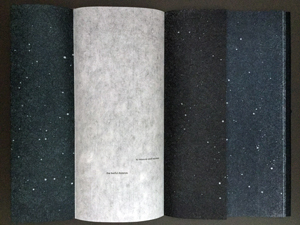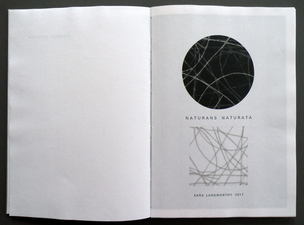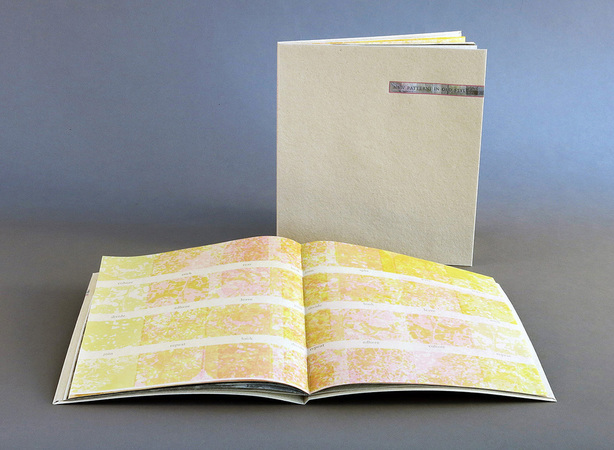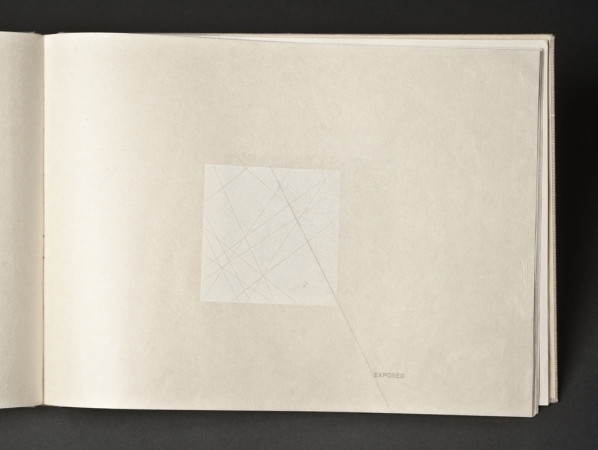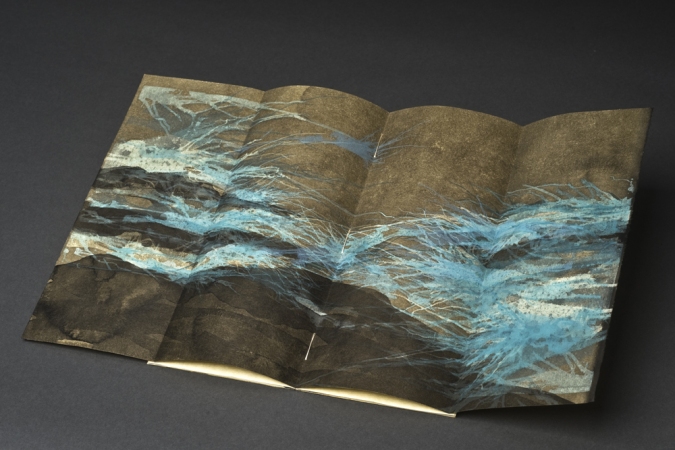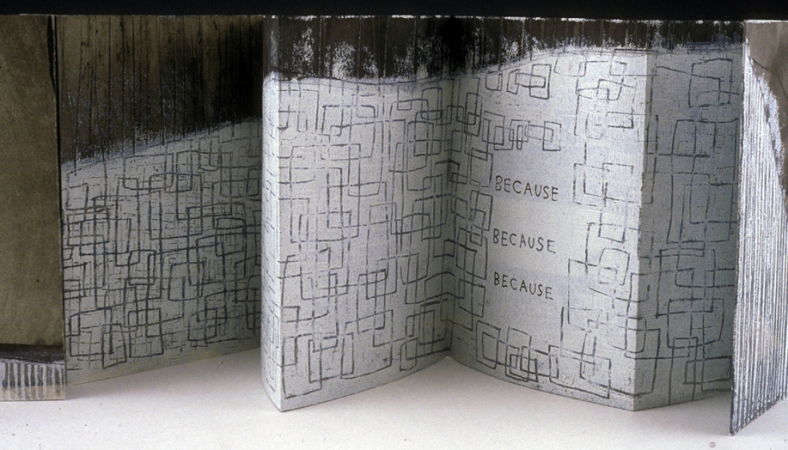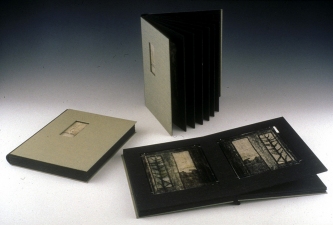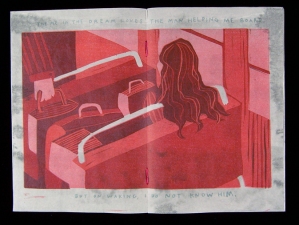click on image or title for more images and to read longer descriptions of each book
SIDEREAL, 2019.
Edition of 35. Letterpress, collagraph, pressure print, hand-set Univers types. Longstitch binding with a limp paper wrapper, housed in a clamshell box. 12 x 7.5 inches (closed)
$2250
The word sidereal means of or with respect to the distant stars.
The stars [appear to] move across the sky because we move. Or rather, the orb on which we live moves. Wandering star means planet: a bright star moving at its own pace through the sky. We live on a wandering star. We think we see the stars move. They might already be gone.
This artist book, Sidereal, is about the vastness of the sky and the distance of the stars. It is about how we comprehend and measure that distance. It is about how perspective, placement and location affect how we perceive what is around us. It is about the distance that separates us, and the space that connects us. It is about things disappearing in plain sight, being present and lost at the same time. It is about patiently waiting centuries to find answers to our questions.
Images are built by combining two letterpress processes: relief printed collagraph blocks, and pressure printing. The relief blocks print a fine brushmark pattern. The prints each use between nine and 14 collagraph blocks. The overlayering of the patterned brushmarks builds a dense pattern of fine lines similar to crosshatching. For each layer of the image, I change out the relief block, but keep using the same pressure print template. The stars were slowly built, layering ink and leaving the points of light blank. The type is handset Univers, purchased from the M&H Typefoundry. The paper is Okawara Handmade. The binding is a longstitch, with the bound book fitted into a modified conservation rebind wrapper. The edition size is 35. The book is housed in a drop spine box. Closed, Sidereal measures 12 inches tall, by 7.5 inches wide, with a spine width of ½ inch.
Text for this book was excerpted and reassemble from The Heavens (1873) by Amedee Guillemin, specifically from the chapters about stars.
Edition of 35. Letterpress, collagraph, pressure print, hand-set Univers types. Longstitch binding with a limp paper wrapper, housed in a clamshell box. 12 x 7.5 inches (closed)
$2250
The word sidereal means of or with respect to the distant stars.
The stars [appear to] move across the sky because we move. Or rather, the orb on which we live moves. Wandering star means planet: a bright star moving at its own pace through the sky. We live on a wandering star. We think we see the stars move. They might already be gone.
This artist book, Sidereal, is about the vastness of the sky and the distance of the stars. It is about how we comprehend and measure that distance. It is about how perspective, placement and location affect how we perceive what is around us. It is about the distance that separates us, and the space that connects us. It is about things disappearing in plain sight, being present and lost at the same time. It is about patiently waiting centuries to find answers to our questions.
Images are built by combining two letterpress processes: relief printed collagraph blocks, and pressure printing. The relief blocks print a fine brushmark pattern. The prints each use between nine and 14 collagraph blocks. The overlayering of the patterned brushmarks builds a dense pattern of fine lines similar to crosshatching. For each layer of the image, I change out the relief block, but keep using the same pressure print template. The stars were slowly built, layering ink and leaving the points of light blank. The type is handset Univers, purchased from the M&H Typefoundry. The paper is Okawara Handmade. The binding is a longstitch, with the bound book fitted into a modified conservation rebind wrapper. The edition size is 35. The book is housed in a drop spine box. Closed, Sidereal measures 12 inches tall, by 7.5 inches wide, with a spine width of ½ inch.
Text for this book was excerpted and reassemble from The Heavens (1873) by Amedee Guillemin, specifically from the chapters about stars.
NATURANS NATURATA, 2017
Edition of 25. Letterpress, relief, pressure prints. Sewn boards binding, housed in a clamshell box.
$1500-
WINNER of the Carl Hertzog Award for Excellence in Book Desgin.
Naturans Naturata explores the infinite order and connection of things. Both the chaos when everything is connected, and the stillness where connections can be recognized. Using layered prints of simple geometric forms, texts from geometry primers and Spinoza's ETHICS, on some pages the imagery is spare and objects are easily discerned. On other pages prints are so heavily layered that individual shapes are completely obscured.
Edition of 25. Letterpress, relief, pressure prints. Sewn boards binding, housed in a clamshell box.
$1500-
WINNER of the Carl Hertzog Award for Excellence in Book Desgin.
Naturans Naturata explores the infinite order and connection of things. Both the chaos when everything is connected, and the stillness where connections can be recognized. Using layered prints of simple geometric forms, texts from geometry primers and Spinoza's ETHICS, on some pages the imagery is spare and objects are easily discerned. On other pages prints are so heavily layered that individual shapes are completely obscured.
ON PHYSICAL LINES, 2015
Edition of 25.
OUT OF PRINT
8.5 x 13.5 inches, housed in a clamshell box.
On Physical Lines depicts tangled observations and the messy work needed to move from one state of understanding to another. Prints of drawings of power lines are paired with sentences excerpted from the paper “On Physical Lines of Force,” written by Scottish physicist James Clerk Maxwell in 1861. Presented in fragments, Maxwell’s reconfigured words narrate positions of questions and dissatisfaction as constructive conditions of the creative process. The book takes as its starting point a quotation from Maxwell, given in a lecture at Kings College London, 1860:
"We shall find that it is the peculiar function of physical science to lead us, by the steps of rigid demonstration, to the confines of the incomprehensible, and to encourage us to apply our minds to that which we do not yet understand, since it is only to those who labour patiently and think steadily, that such mysteries are ever opened."
On Physical Lines was designed, printed, and bound by Sara Langworthy in Iowa City, IA. The text is printed from hand-set Univers. Images are printed from linoleum blocks and photopolymer plates made from drawings of power lines. The paper is Sakamoto Lightweight, and the pages are assembled in a Simplified Binding with leather spine and iris bookcloth covers.
Text for this book was derived from the paper “On Physical Lines of Force,” written by Scottish physicist James Clerk Maxwell in 1861.
Edition of 25.
OUT OF PRINT
8.5 x 13.5 inches, housed in a clamshell box.
On Physical Lines depicts tangled observations and the messy work needed to move from one state of understanding to another. Prints of drawings of power lines are paired with sentences excerpted from the paper “On Physical Lines of Force,” written by Scottish physicist James Clerk Maxwell in 1861. Presented in fragments, Maxwell’s reconfigured words narrate positions of questions and dissatisfaction as constructive conditions of the creative process. The book takes as its starting point a quotation from Maxwell, given in a lecture at Kings College London, 1860:
"We shall find that it is the peculiar function of physical science to lead us, by the steps of rigid demonstration, to the confines of the incomprehensible, and to encourage us to apply our minds to that which we do not yet understand, since it is only to those who labour patiently and think steadily, that such mysteries are ever opened."
On Physical Lines was designed, printed, and bound by Sara Langworthy in Iowa City, IA. The text is printed from hand-set Univers. Images are printed from linoleum blocks and photopolymer plates made from drawings of power lines. The paper is Sakamoto Lightweight, and the pages are assembled in a Simplified Binding with leather spine and iris bookcloth covers.
Text for this book was derived from the paper “On Physical Lines of Force,” written by Scottish physicist James Clerk Maxwell in 1861.
NEW PATTERNS IN OLD STYLE, 2013
Edition of 24. $850.
8.75 x 9.5 in. (closed)
New Patterns in Old Style explores the dual meaning of the word cleave, investigating the state of being two things at once. The tension present when conflicting impulses exist within a single word or being is depicted using images based on tatting instructions and decayed leaves. The book combines images and text printed from photopolymer plates with hand-brushed sumi ink painting. Letterpress printed from photopolymer plates on Kitakata, Kozo Kaiga, and handmade papers. Limp paper binding using UICB handmade flax cover sheets, housed in a clamshell box.
Edition of 24. $850.
8.75 x 9.5 in. (closed)
New Patterns in Old Style explores the dual meaning of the word cleave, investigating the state of being two things at once. The tension present when conflicting impulses exist within a single word or being is depicted using images based on tatting instructions and decayed leaves. The book combines images and text printed from photopolymer plates with hand-brushed sumi ink painting. Letterpress printed from photopolymer plates on Kitakata, Kozo Kaiga, and handmade papers. Limp paper binding using UICB handmade flax cover sheets, housed in a clamshell box.
SOLID PHASES, 2012
Edition of 33. $700
Solid Phases is inspired by drawings of the molecular structure of ice, and the language used to describe the brittle bond of water in its solid phase. The text is culled from the book “Ice Physics” (Peter V. Hobbs, 1974) in particular the first section of the book entitled “Solid Phases of the Water Substance.” This book explores the fragile nature of connection, tendency towards stasis despite change, and the impact of stress upon a solid.
Letterpress printed from metal type, photopolymer plates, and linoleum blocks.
Edition of 33. $700
Solid Phases is inspired by drawings of the molecular structure of ice, and the language used to describe the brittle bond of water in its solid phase. The text is culled from the book “Ice Physics” (Peter V. Hobbs, 1974) in particular the first section of the book entitled “Solid Phases of the Water Substance.” This book explores the fragile nature of connection, tendency towards stasis despite change, and the impact of stress upon a solid.
Letterpress printed from metal type, photopolymer plates, and linoleum blocks.
MORPHO TERRESTRE, 2006
Poems by Emily Wilson, prints by Sara Langworthy
Edition of 50. $600
Morpho Terrestre consists of seven poems by Emily Wilson, with four companion images hidden behind gatefold pages. The poems revolve around an extremely close examination of the natural world, taking as their point of departure Micrographia, Robert Hooke’s 17th c. treatise on the microscope. The prints are multi-layered, employing both relief printing on a Vandercook press from photopolymer plates, and hand painted sumi ink washes. The images are hidden behind gatefolds, giving the viewer the opportunity to experience the text itself, without a visual interpretation obstructing the reading of the poem.
Book is soft covered, sewn with silk in a Japanese Multisection binding. The poems were digitally composed using Janson types, and printed from photopolymer plates on Sakamoto Lightweight paper. The book is housed in an oversized clamshell box, it provides a a safe viewing area for the fully extended book.
Poems by Emily Wilson, prints by Sara Langworthy
Edition of 50. $600
Morpho Terrestre consists of seven poems by Emily Wilson, with four companion images hidden behind gatefold pages. The poems revolve around an extremely close examination of the natural world, taking as their point of departure Micrographia, Robert Hooke’s 17th c. treatise on the microscope. The prints are multi-layered, employing both relief printing on a Vandercook press from photopolymer plates, and hand painted sumi ink washes. The images are hidden behind gatefolds, giving the viewer the opportunity to experience the text itself, without a visual interpretation obstructing the reading of the poem.
Book is soft covered, sewn with silk in a Japanese Multisection binding. The poems were digitally composed using Janson types, and printed from photopolymer plates on Sakamoto Lightweight paper. The book is housed in an oversized clamshell box, it provides a a safe viewing area for the fully extended book.
WITHOUT QUESTION, 2001
Edition of 75. $175
Without Question is a joyful shout to the unasked "why?" celebrating texture, close examination of surroundings, and process. The pages were heavily worked with layers of printing from photopolymer plates, hand painted sumi ink washes, mark making and scratching the paper, and trace monoprints. Paper is Domestic Etching, assembled into an accordion binding. Book housed in a 3-flap portfolio covered with blue-gold Japanese bookcloth and secured with a magnet closure.
Edition of 75. $175
Without Question is a joyful shout to the unasked "why?" celebrating texture, close examination of surroundings, and process. The pages were heavily worked with layers of printing from photopolymer plates, hand painted sumi ink washes, mark making and scratching the paper, and trace monoprints. Paper is Domestic Etching, assembled into an accordion binding. Book housed in a 3-flap portfolio covered with blue-gold Japanese bookcloth and secured with a magnet closure.
First Visit describes a restless night in an unfamiliar place. The images were first the proofs of intaglio prints, then drawn on, then transferred to acetate. One side of the image is a color reproduction, the other is black and white. The two transfers were glued together, with kozo paper sandwiched between. Strings are embedded in the acetate, and allow the images to hang suspended in the cut out window pages of the stiff leaf album binding. A window cut in the the front and back covers allow for light to pass through the entire book. The light gets brighter as the pages turn.
Produced with an Artist Book Production Grant from the Women's Studio Workshop.
Edition of 40, completed in 2001
OUT OF PRINT
Produced with an Artist Book Production Grant from the Women's Studio Workshop.
Edition of 40, completed in 2001
OUT OF PRINT
Even Sleeping I Stay Put: Travel Dreams Thwarted
Dreams of dubious travel, lost love, and breakfast. Printed using reduction linoleum prints and hand-written text printed from photopolymer plates. Paper is a thin chinese tissue, painted on the back side with diluted sumi ink. Pages are french folds, and the book is assembled in a Japanese Multisection binding sewn with red silk thread.
Edition of 24, completed in 2004.
OUT OF PRINT
Dreams of dubious travel, lost love, and breakfast. Printed using reduction linoleum prints and hand-written text printed from photopolymer plates. Paper is a thin chinese tissue, painted on the back side with diluted sumi ink. Pages are french folds, and the book is assembled in a Japanese Multisection binding sewn with red silk thread.
Edition of 24, completed in 2004.
OUT OF PRINT
